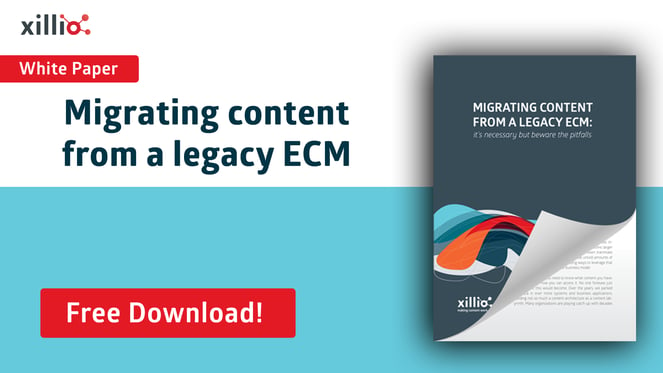The smart way to migrate: integration and redirection
by Sjoerd Alkema, on Apr 3, 2023 4:52:00 PM
This is part 2 of a series of blogs discussing the impact of content migrations and the best practices to streamline it.
In the last blog "The smart way to migrate: Taking your users into consideration", I discussed the importance of users and how we take care of that in our smart way to migrate approach. The next topic I'd like to address is integration challenges. Typically, these legacy ECM systems have been around for a while and are deeply embedded in the application architecture of our customers. Think about e-mail integration. This means that you can't just move out the content to the new Content Services platform and expect everything will continue as it should.
Application integrations
In our discovery phase, identifying and mapping out integrations is an essential part of the process. Integrations can be on multiple levels: application layer or data layer. To minimize disruption caused by migration to a new platform, we must clearly identify all of them and assess how these integrations could be re-built in the new target platform. Identifying these integrations as soon as possible is key to providing business continuity for our clients.
Email and office integration
One specific integration I'd like to address is the option to store and archive files easily from within Outlook and Microsoft Office. Many of the old ECM suite vendors have spent quite some effort in developing these integrations to make life easier for their users, allowing them to remain in the interface they were all working in (E-mail, MS Word) and not having to bother too much about the more complicated ECM applications.
However, we can try and be smart about it too: we can provide the same integrations as previous versions provided, but then for Microsoft 365 fully serviced in the cloud. This is a tremendous boost for adoption--and can make or break your implementation. Next to that, from a compliance perspective, making it easy for users to store their valuable documents from their primary working environments with correct metadata applied automatically is also essential.

Document integration via links
Another way to integrate is by using links to refer to documents in other applications. Still having one version of the truth in your legacy ECM repository but having links from other apps to it. Think of knowledge management systems, pointing to documents, Intranet sites, but also HR and Finance task-oriented systems can have these types of integrations. And yes, when you migrate all these documents into a new platform, those links break.
Of course, being smart about migrations we have a solution for this too. In this specific use case, we can provide the Link Redirector as part of our migration services. This captures the original request (to the old legacy system document) and redirects to the new location of the file after migration. It does not matter where the redirect is coming from, therefore you don't even have to worry about what systems potentially have these links.
To learn more about Link Redirector, watch the webinar recap
Keeping track of content during the migration
In addition to the after-migration use case, there is another: the during-migration use case. Migrations with substantial amounts of volume take some time, but so does learning how to use a new system and working in it in an efficient way. This results in phases where different departments are migrated at different times--first, bring over department X with all their old data, then start working in the new system; then migrate department Y and so on.
These sequential changes mean that at some point in time, department X will already be working in the new system while department Y has yet to begin migrating. The Link Redirector can help minimize any impact of this by pointing users who open documents created by migrated users to their new locations without them even knowing it is happening--thus saving time, difficult planning and explaining during change management processes.
All in all, whenever migration of content is not an option, or during the time it is being migrated, there are viable solutions for keeping and making your content accessible. It is important to assess the need for this at the earliest possible stage, and here we can help you by inventorying the dependencies as part of our content analysis service.
Want to learn more about how to maximize your end-users experience throughout the whole migration journey? Read part 1 of this blog series "The smart way to migrate: Taking your users into consideration"!
Migrating content from a legacy ECM
Is your legacy archive killing your business? How to migrate your content to accelerate growth, increase customer satisfaction and improve the digital experience
This white paper explores the challenges holding back your initiatives to consolidate content from one or more stale and outdated legacy content repositories as you drive your business along the road of digital transformation. It provides insights and experiences that have triggered our clients to reach out to us for guidance and heavy-duty work to overcome those challenges.





%20(300%20x%2060%20px)%20(3).png?width=635&height=127&name=ISO%20email%20signature%20(390%20x%2060%20px)%20(300%20x%2060%20px)%20(3).png)